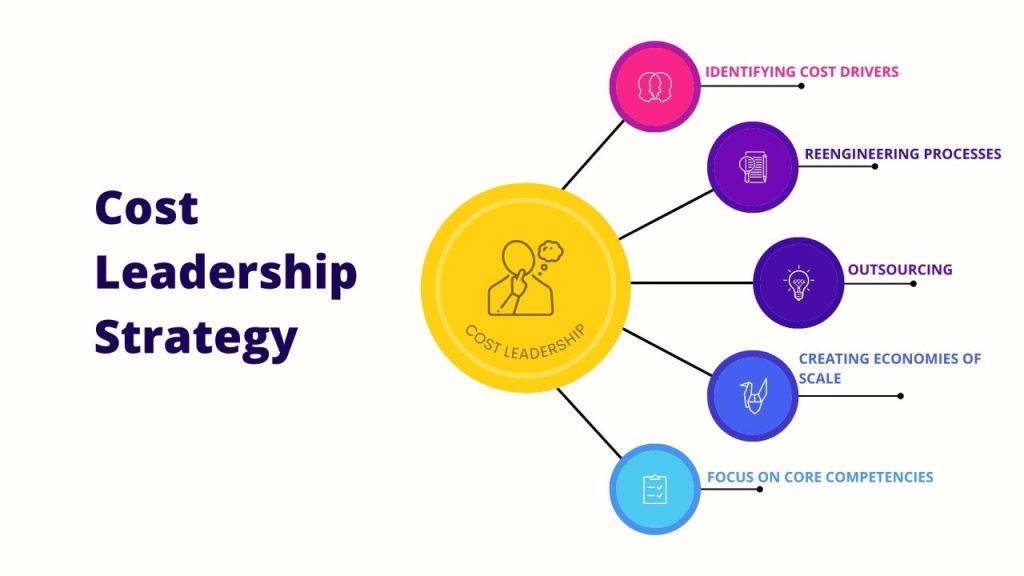In the ever-evolving landscape of business, companies are constantly seeking ways to gain a competitive edge, increase market share, and maximize profitability. One effective strategy that has stood the test of time is cost leadership.
Contact us today for a tailor-made Cost Leadership Strategy!
In this article, we’ll delve into the intricacies of cost leadership as a business strategy, exploring its principles, benefits, and implementation strategies.
Understanding Cost Leadership
Cost leadership is a business strategy where a company aims to become the lowest-cost producer in its industry or market segment. By minimizing production costs, operating expenses, and overheads, cost leaders can offer products or services at lower prices than their competitors while maintaining acceptable levels of quality. This allows them to attract price-sensitive customers and gain a larger market share.
Principles of Cost Leadership
- Efficiency in Operations: Cost leaders focus on optimizing their operations to reduce waste, improve productivity, and lower production costs. This may involve streamlining processes, investing in automation, or renegotiating supplier contracts to secure lower prices for raw materials or components.
- Economies of Scale: Cost leaders leverage economies of scale to drive down costs per unit by increasing production volume. As production levels rise, fixed costs such as machinery, equipment, and facilities are spread over a larger output, resulting in lower average costs.
- Supply Chain Optimization: Cost leaders work closely with suppliers to negotiate favorable terms, secure discounts, and minimize transportation and inventory costs. They may also adopt just-in-time inventory management practices to reduce carrying costs and improve cash flow.
- Product Simplification: Cost leaders simplify product designs and features to reduce manufacturing complexity and production costs. By focusing on essential features and functionalities, they can produce goods more efficiently and cost-effectively.
Benefits of Cost Leadership
- Competitive Advantage: Cost leaders can offer products or services at lower prices than their competitors, making them more attractive to price-sensitive customers. This allows them to gain market share and maintain a competitive edge in the industry.
- Increased Market Share: Lower prices can help cost leaders capture a larger share of the market, especially in price-sensitive segments. As they expand their customer base, they can achieve economies of scale and further reduce costs.
- Profitability: While cost leaders operate on thin profit margins, their high volume of sales compensates for lower prices, resulting in overall profitability. By minimizing costs and maximizing efficiency, they can achieve sustainable profitability even in highly competitive markets.
- Barriers to Entry: Establishing cost leadership can create barriers to entry for new competitors. The high volume and low prices achieved by cost leaders make it challenging for new entrants to compete effectively without significant investment in production capabilities and cost reduction strategies.
Implementation of Cost Leadership Strategy
- Cost Analysis: Conduct a comprehensive analysis of all costs associated with production, operations, and distribution. Identify areas where costs can be reduced without compromising quality or customer satisfaction.
- Operational Efficiency: Implement measures to improve operational efficiency, such as lean manufacturing techniques, process optimization, and workforce training. Streamline workflows, eliminate bottlenecks, and reduce waste to minimize costs.
- Supplier Relationships: Develop strong relationships with suppliers and negotiate favorable terms, discounts, and payment terms. Explore opportunities for bulk purchasing, long-term contracts, and strategic partnerships to lower procurement costs.
- Investment in Technology: Invest in technology and automation to enhance productivity, reduce labor costs, and improve overall efficiency. Implement software solutions, robotics, and advanced manufacturing technologies to streamline processes and minimize manual intervention.
- Continuous Improvement: Adopt a culture of continuous improvement and innovation to identify cost-saving opportunities and drive efficiencies across the organization. Encourage employee involvement and feedback to identify areas for improvement and implement solutions effectively.
Conclusion
Cost leadership is a powerful business strategy that enables companies to gain a competitive advantage, increase market share, and achieve sustainable profitability. By focusing on efficiency, economies of scale, and operational excellence, cost leaders can offer products or services at lower prices than their competitors while maintaining profitability. Through strategic cost management, optimization of operations, and continuous improvement, companies can successfully implement cost leadership and thrive in today’s competitive business environment.


